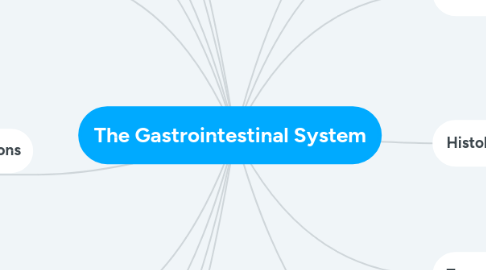
1. Large intestine
2. Respiratory System
3. Renal System
4. Saliva
4.1. Control
4.1.1. Stimulation
4.1.1.1. Tactile
4.1.1.2. ANS
4.1.1.2.1. PNS
4.1.1.2.2. SNS
4.1.1.3. Cognitive
4.1.1.3.1. Conditioning
4.2. Functions
4.2.1. Lubrication & Moistening
4.2.2. Antibacterial
4.2.3. Digestion
4.2.3.1. Minor
4.2.3.2. Enzymes
4.2.3.2.1. Amylase
4.2.3.2.2. Lipase
5. Major Organs
5.1. Stomach
5.1.1. Gastric Rugae
5.2. Esophagus
5.3. Intestines
5.3.1. Small intestine
5.3.1.1. Duodenum
5.3.1.2. Jejunum
5.3.1.3. Ileum
5.3.2. Large intestine
5.3.2.1. Ascending Colon
5.3.2.1.1. Cecum (Caecum)
5.3.2.1.2. Appendix
5.3.2.2. Transverse Colon
5.3.2.3. Descending Colon
5.4. Rectum
5.5. Pharnyx
5.6. Anus
5.7. Mouth/Oral Cavity
6. Prevention of Acid Secretion
6.1. H2 receptor blockers
6.1.1. TZP
6.2. Proton pump inhibitors
6.2.1. PP
7. Cystic fibrosis (Mucoviscidosis)
7.1. Defective chloride channel
7.1.1. Gene mutation
7.1.2. water secretion
8. Anatomy
8.1. Accessory Organs
8.1.1. Pancreas
8.1.2. Oral Cavity
8.1.2.1. Teeth
8.1.2.2. Tongue
8.1.2.3. Salivary Glands
8.1.2.3.1. Submandibular
8.1.2.3.2. Parotid
8.1.2.3.3. Sublingual
8.2. Structure
9. Histology
9.1. Gastric Rugae
9.2. Small Intestine
9.3. Tissue Layers
9.4. Enteric Plexus
9.4.1. Myenteric plexus
9.4.2. Submucousal plexus
10. Functions
10.1. Secretion
10.1.1. Gastric
10.1.2. Lubrication
10.1.3. Liquifying
10.1.3.1. Aids absorption
10.1.3.2. Neutralization
10.1.4. Digestion
10.2. Storage and Elimination
10.3. Absorption
10.3.1. Water
10.3.1.1. Vital to survival
10.3.1.2. Major uptake in small intestine
10.3.2. Vitamin B-12
10.3.2.1. Intrinsic factor
10.3.2.1.1. Ileum
10.3.3. Transport
10.4. Digestion
10.4.1. Mechanical
10.4.2. Chemical
10.5. Propulsion/Motility
10.5.1. Reflexes
10.5.1.1. Peristalsis
10.5.1.1.1. Peristalsis reflex
10.5.1.1.2. Weak but repetitive
10.5.1.2. Enteroenteric
10.5.1.2.1. Inhibition of peristalsis
10.5.1.3. Ileogastric
10.5.1.3.1. No room
10.5.1.3.2. Gastric emptying slowed
10.5.1.3.3. similar to enteroenteric
10.5.1.4. Gastroileal
10.5.1.5. Colonileal
10.5.1.6. Gastrocolic
10.5.1.6.1. Defecation
10.5.1.6.2. IAS to relax
10.5.1.6.3. EAS -> voluntary
10.5.1.6.4. gastric/duodenal distension
10.5.2. Ingestion
10.5.2.1. Stomach
10.5.2.1.1. Wringing motion (oblique muscle)
10.5.2.1.2. Mixing and Churning
10.5.2.1.3. Gastrogastric reflex
10.5.2.1.4. Peristaltic waves
10.5.2.2. Esophagus
10.5.2.2.1. Weak peristalsis
10.5.2.2.2. UES under voluntary control (skeletal muscle)
10.5.2.3. Small intestine
10.5.2.3.1. Movements
10.6. Immune Barrier
11. Chemistry
11.1. Buffer Chemistry
12. Metabolism Contribution
13. Terms to Remember
14. Gastrointestinal Diseases/Conditions
14.1. Too much gastric secretion
14.1.1. H. pylori
14.1.1.1. Urease
14.1.1.2. Toxins
14.1.2. GERD
14.1.3. Peptic Ulcer Disease
14.2. Gallstones
14.2.1. 80% cholesterol
14.2.2. 20% bilirubin and calcium
14.2.2.1. pigment stones
14.2.3. Very painful
14.2.4. Surgical gallbladder removal
15. Other Body System Intergrations
15.1. Acid/Base Balance Mechanism
15.2. Endocrine System
15.2.1. GI Hormones
15.3. Immune Barrier
16. Secretion
16.1. Stomach
16.1.1. Gastric
16.1.1.1. Epithelium
16.1.1.1.1. Exocrine
16.1.1.1.2. Endocrine
16.1.1.2. Acid
16.1.1.2.1. Alkaline Tide
16.1.1.2.2. Protein digestion
16.1.1.2.3. Bacteriocidal
16.1.1.2.4. Bone digestion
16.1.1.2.5. K+/H+ ATPase
16.1.1.2.6. Secretagogues
16.1.1.2.7. Anti-secretagogues
16.1.1.3. Other
16.1.1.3.1. Gastric lipase
16.1.1.3.2. Gelatinase
16.1.1.3.3. Gastric amylase
16.1.2. Control
16.1.2.1. Cephalic Phase
16.1.2.1.1. sight
16.1.2.1.2. smell
16.1.2.1.3. thought
16.1.2.1.4. Medulla Oblongata
16.1.2.1.5. Histamine
16.1.2.1.6. Gastrin
16.1.2.2. Gastric Phase
16.1.2.2.1. Triggered by food
16.1.2.2.2. Gastrogastric reflex
16.1.2.2.3. Negative feedback at pH <2
16.1.2.3. Intestinal Phase
16.1.2.3.1. Enterogastric reflex
16.1.2.3.2. Anti-secreto.
16.1.2.3.3. motility
16.2. Small intestine
16.2.1. Pancreas
16.2.1.1. Endocrine
16.2.1.1.1. [Blood sugar] control
16.2.1.1.2. Insulin
16.2.1.1.3. Glucagon
16.2.1.2. Exocrine
16.2.1.2.1. Enzymes
16.2.1.2.2. Out through pancreatic duct
16.2.1.2.3. Aqueous
16.2.1.3. Control
16.2.1.3.1. secretion
16.2.2. Liver
16.2.2.1. Bile production
16.2.2.1.1. Bile acids
16.2.2.1.2. Bicarbonate
16.2.2.1.3. by Secretin
16.2.3. Gallbladder
16.2.3.1. Bile acids
16.2.3.1.1. Re-absorption
16.2.3.1.2. made by hepatocytes
16.2.3.1.3. oxidation of cholesterol
16.2.3.1.4. cholesterol synthesis = very energy consuming
16.2.3.1.5. 20-30 mg/day secreted
16.2.3.1.6. bile salts
16.2.3.2. Concentrated bile
16.2.3.2.1. 5-15x
16.2.3.3. stores 30-60 ml
16.2.3.4. ~500 ml/day
16.2.3.5. Emptying control
16.2.3.5.1. CCK
16.2.3.5.2. Weak vagus nerve stimulation
16.2.4. Paneth cells
16.2.4.1. Control
16.2.5. Control

